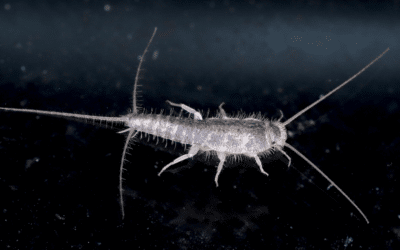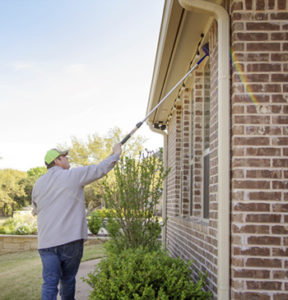 It’s been said that you’re never more than a few feet away from a spider – and that’s especially true in Texas. It’s hard to go too long without running into one. Everyone should have a basic understanding of the types of spiders you’ll find in Texas. As well as how to avoid having to share your homes with them! Fortunately, only two of the spiders commonly found in Central Texas are potentially harmful to humans. This article will cover the most common families of spiders found in Texas. And what you can do to prevent them from finding their way into your spaces.
It’s been said that you’re never more than a few feet away from a spider – and that’s especially true in Texas. It’s hard to go too long without running into one. Everyone should have a basic understanding of the types of spiders you’ll find in Texas. As well as how to avoid having to share your homes with them! Fortunately, only two of the spiders commonly found in Central Texas are potentially harmful to humans. This article will cover the most common families of spiders found in Texas. And what you can do to prevent them from finding their way into your spaces.
Walking right smack into the middle of a spider web is a rite of passage for most Texans. Even with the knowledge that the vast majority of these arachnids pose no threat to us – they can still manage to make the skin crawl. Spiders are an important part of the ecosystem and they’re pest control experts in their own right. Spiders are insectivores, predators that largely dine on insects like ants, mosquitos, and flies – or even other spiders. The bottom line is that without spiders – we’d be dealing with a whole lot more pests. So when you step outside with a flashlight and see all the eyes in the grass – think of them as your own squad of insect hunters.
Grass Spiders
Most of the eyes you’ll see looking back at you from your yard at night will be this type. Grass spiders weave funnel webs between blades of grass to trap their prey. These spiders are often confused with Wolf Spiders. The lines down their back are typically not as pronounced and they are smaller. These spiders aren’t venomous (unlike the Wolf Spider) and are non-aggressive. You really don’t have anything to worry about when it comes to these grass-dwelling arachnids.
Crab Spiders
Crab spiders like flowers, and leaves. While some species frequent the ground. Their name comes from the way their front legs pull back in a pair, and the way they can scuttle left and right, akin to a crab. Crab spiders don’t make webs, preferring to catch their prey manually.
Tarantulas
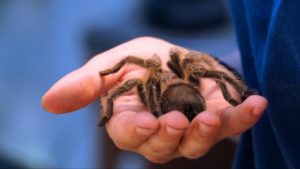 Tarantulas are some of the biggest spiders to be seen in Texas. These spiders keep to themselves and are rarely seen outside of the mating season. when males will leave their burrows in search of a mate. These spiders live in burrows covered with their silken web – even blocking in with dirt during the warm months. They use this burrow like a hunter uses a deer blind, waiting for their prey to come to them. This may sound rough, but these spiders are patient predators and can go weeks without eating. Although their bite is not dangerous, they do have hairs on their abdomen that can irritate humans.
Tarantulas are some of the biggest spiders to be seen in Texas. These spiders keep to themselves and are rarely seen outside of the mating season. when males will leave their burrows in search of a mate. These spiders live in burrows covered with their silken web – even blocking in with dirt during the warm months. They use this burrow like a hunter uses a deer blind, waiting for their prey to come to them. This may sound rough, but these spiders are patient predators and can go weeks without eating. Although their bite is not dangerous, they do have hairs on their abdomen that can irritate humans.
Wolf Spider
You’ve probably seen a Wolf Spider. These spiders can get relatively large (up to three inches across) and they’re highly common. They’re usually recognized by the long black stripes along their back (cephalothorax in spider-speak). And can easily make their way indoors. These spiders see well at night and often hunt in the dark. Although they are venomous, their bites are rarely medically significant, at worst akin to the sting of a wasp.
Jumping Spider
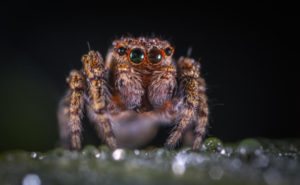 Jumping spiders are the quick and compact spiders you’ll often see in a wide range of bright colors. As the name implies, these spiders excel at hopping from place to place. Their excellent vision helps them in this regard. Although they don’t spin webs, they use their webbing as a fall-back tether for failed launches. You can catch them dangling from leaves or ceilings when this takes place. These spiders do have fangs and venom, but rarely bite humans and don’t do much damage when they do.
Jumping spiders are the quick and compact spiders you’ll often see in a wide range of bright colors. As the name implies, these spiders excel at hopping from place to place. Their excellent vision helps them in this regard. Although they don’t spin webs, they use their webbing as a fall-back tether for failed launches. You can catch them dangling from leaves or ceilings when this takes place. These spiders do have fangs and venom, but rarely bite humans and don’t do much damage when they do.
Orbweaver Spiders
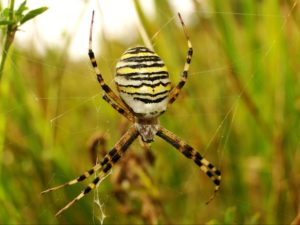 Orbweavers are a highly varying group of spiders. Famous for their concentric and ornate webs. Masters of web weaving, use seven different types of silk to craft their webs. Often these webs are torn down and rebuilt each day. These spiders are adept at quickly attacking the prey that finds themselves trapped by the web. Wrapping the prey in silk to immobilize and prevent it from destroying the web. Orbweavers don’t have the keen eyesight that many of their peers possess, and count on movements of their web to inform them of when the prey has landed. The larger yellow and black orb weaver typically found in gardens is one of the most popular in Texas. It can grow to be nearly 3 inches from leg to leg. The most dangerous aspect of an Orbweaver is walking through its web. They pose no threat to humans.
Orbweavers are a highly varying group of spiders. Famous for their concentric and ornate webs. Masters of web weaving, use seven different types of silk to craft their webs. Often these webs are torn down and rebuilt each day. These spiders are adept at quickly attacking the prey that finds themselves trapped by the web. Wrapping the prey in silk to immobilize and prevent it from destroying the web. Orbweavers don’t have the keen eyesight that many of their peers possess, and count on movements of their web to inform them of when the prey has landed. The larger yellow and black orb weaver typically found in gardens is one of the most popular in Texas. It can grow to be nearly 3 inches from leg to leg. The most dangerous aspect of an Orbweaver is walking through its web. They pose no threat to humans.
Widow Spiders
Black Widows are well-known in Texas. They’re one of the most dangerous spiders in the state and have an iconic look.
The southern black widow possesses a highly concentrated venom that can kill small animals. They’re also known to kill their mates, hence the name.
Black widows have hourglass-shaped triangles on their rounded abdomen. They spin chaotic and disorganized webs, hanging and waiting for their prey to enter the cavity or area they’ve built it in.
Although they aren’t aggressive, most bites happen when people unknowingly stick their hand in the widow’s web or accidentally brush up against them. If you find yourself bitten by a widow, seek medical attention. Although their bites are rarely fatal, they bring a great deal of pain and discomfort and can be dangerous when not treated appropriately.
Recluse Spiders
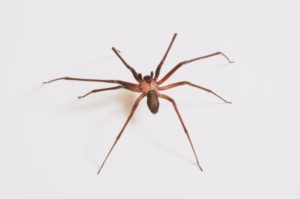 Brown recluses are famous. Just not for the reasons most of us would want to be famous. These spiders don’t use their webs to trap their meals, relying on their venom and quick movements to catch their prey. They spin webs where they stay, and much like widows, their webs are chaotic and haphazard. Unlike widows, recluses typically prefer dryer environments and are commonly found in attics, closets, ductwork, and the ceilings of seldomly disturbed spaces. Known for often sporting a dark and violin-shaped march on their back, these spiders can be more difficult to identify than a widow and easier to mistake for other types of spiders. The venom of a brown recluse is a red blood cell destroying hemotoxin and can cause skin and tissue damage if left unchecked. Like the widow, it’s recommended to seek medical attention if you’re bit by one of these spiders.
Brown recluses are famous. Just not for the reasons most of us would want to be famous. These spiders don’t use their webs to trap their meals, relying on their venom and quick movements to catch their prey. They spin webs where they stay, and much like widows, their webs are chaotic and haphazard. Unlike widows, recluses typically prefer dryer environments and are commonly found in attics, closets, ductwork, and the ceilings of seldomly disturbed spaces. Known for often sporting a dark and violin-shaped march on their back, these spiders can be more difficult to identify than a widow and easier to mistake for other types of spiders. The venom of a brown recluse is a red blood cell destroying hemotoxin and can cause skin and tissue damage if left unchecked. Like the widow, it’s recommended to seek medical attention if you’re bit by one of these spiders.
Ways to Keep Spiders Away
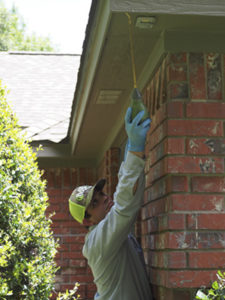
There are plenty of things you can do to prevent spiders from entering your home. Even ways you can make sure your property as a whole isn’t overly inviting. Much of this has to do with making sure your home is sealed well, from windows and doors to your siding and foundation.
When it comes to your property, it’s important to refrain from having piles of debris, wood, or other materials that bugs love.
We’ve covered this in more depth in previous posts, and welcome you to take a look at a blog we did earlier this year detailing how you can prevent pests from overtaking your spaces. When it comes to pest control, it’s imperative to include a professional pest management regiment if you want to ensure results. That’s what the team at 855Bugs pest control Waco and Temple Texas is here for. Schedule a free inspection today, and don’t forget to ask about our Don’t Bug Me plan!


